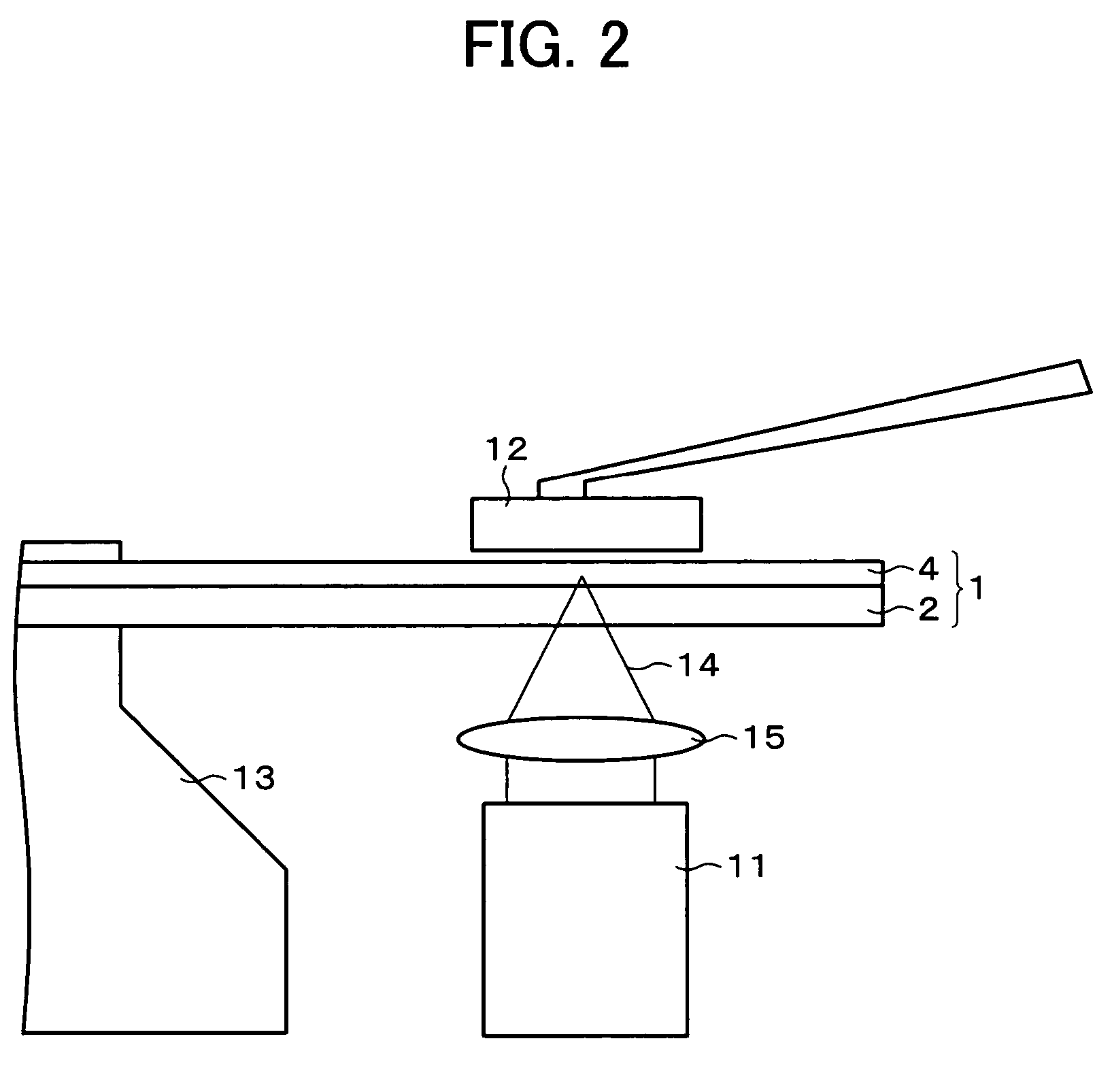Magnetic recording medium and magnetic recording device using the same
a recording medium and magnetic recording technology, applied in mechanical recording, light beam reproducing, instruments, etc., can solve the problem of not being able to obtain sufficient pinning effect, achieve the effect of suppressing magnetic wall movement, reducing recording track width, and improving signal quality
- Summary
- Abstract
- Description
- Claims
- Application Information
AI Technical Summary
Benefits of technology
Problems solved by technology
Method used
Image
Examples
example 1
[0087]The following description will explain a process of manufacturing a magnetic recording medium as an example.
[0088]First, an aluminium film (hereinafter, referred to as “Al underlayer”) which functioned as the underlayer 3 was formed on a glass disk substrate which functioned as the substrate 2 so that its average film thickness was 3.7 nm. The aluminium film was formed in accordance with a direct current magnetron sputtering process at a sputtering pressure of 0.5 Pa.
[0089]Next, a TbFeCo film was formed on a surface of the Al underlayer as the amorphous magnetic layer 4 so that its film thickness was 50 nm. The TbFeCo film was formed in accordance with a direct current magnetron sputtering process at a sputtering pressure of 0.45 Pa. Note that, the TbFeCo film was formed by using an alloy made of Tb23 atomic % (hereinafter, referred to “at %”), Fe60 at %, and Co17 at % as a target in sputtering. Thus formed TbFeCo film was such that: its magnetic compensation point (compensati...
example 2
[0094]Next, surfaces of magnetic layers of the magnetic recording media of Example 1, Comparative Example 1, and Comparative Example 2 were observed from normal direction thereof by means of an atom force microscope (AFM). Micrograms of Example 1, Comparative Example 1, and Comparative Example 2 are respectively shown in FIG. 3, FIG. 4, and FIG. 5.
[0095]In order to observe the surface of the magnetic layer of each of the magnetic recording media of Example 1, Comparative Example 1, and Comparative Example 2, the protective layer 5 and the lubricating layer 6 were omitted from each magnetic recording medium so that its outermost surface was the amorphous magnetic layer 4, thereby obtaining samples. That is, the sample of Example 1 was obtained by providing the aluminium film (underlayer 3) and the TbFeCo film (amorphous magnetic layer 4) on and above the glass disk substrate (substrate 2), and the sample of Comparative Example 1 was obtained by providing the TbFeCo film on the glass ...
example 3
[0099]Next, surface shapes of the magnetic recording media manufactured in Example 1 and Comparative Example 1 were observed by means of an atom force microscope (AFM).
[0100]The surfaces of the magnetic recording media of Example 1 and Comparative Example 1, that is, the surfaces of the lubricating layers 6 were observed from its normal direction by means of the atom force microscope, and the observed surfaces are respectively shown in FIG. 6 and FIG. 7.
[0101]As shown in FIG. 6, in the surface of the magnetic recording medium of Example 1 in which the Al film was provided as the underlayer 3, minute bumps (diameter of each bump was approximately 30 nm) formed on the surface in a high-density manner were observed. Further, at this time, the height of bumps (length from a bottom to a top of the bump) was approximately 4 nm. Here, the layer thickness of the magnetic layer 4 was 50 nm, so that the height of bumps corresponds to 8% with respect to the layer thickness of the magnetic laye...
PUM
| Property | Measurement | Unit |
|---|---|---|
| diameter | aaaaa | aaaaa |
| thickness | aaaaa | aaaaa |
| melting point | aaaaa | aaaaa |
Abstract
Description
Claims
Application Information
 Login to View More
Login to View More - R&D
- Intellectual Property
- Life Sciences
- Materials
- Tech Scout
- Unparalleled Data Quality
- Higher Quality Content
- 60% Fewer Hallucinations
Browse by: Latest US Patents, China's latest patents, Technical Efficacy Thesaurus, Application Domain, Technology Topic, Popular Technical Reports.
© 2025 PatSnap. All rights reserved.Legal|Privacy policy|Modern Slavery Act Transparency Statement|Sitemap|About US| Contact US: help@patsnap.com



